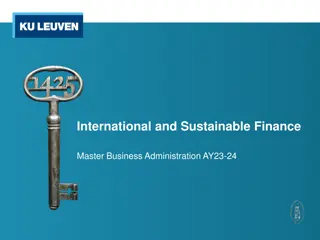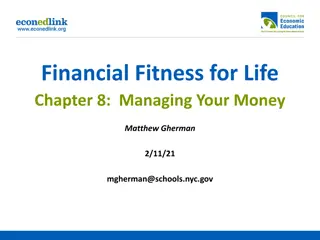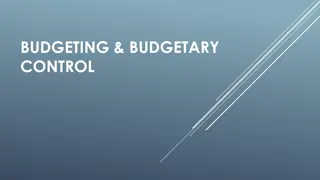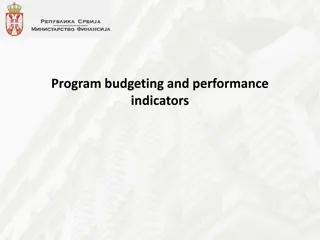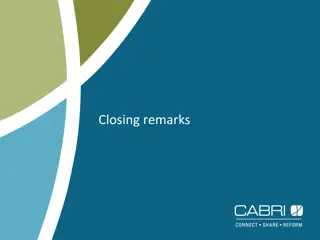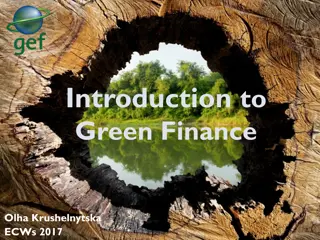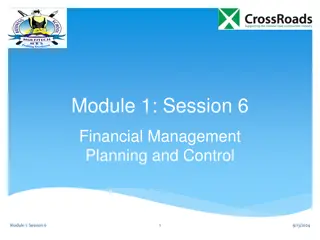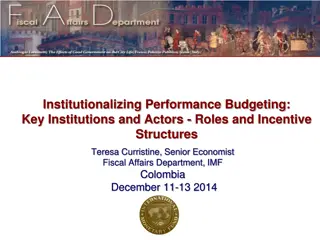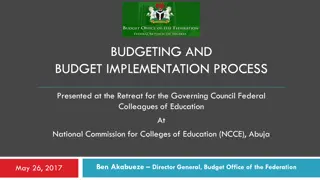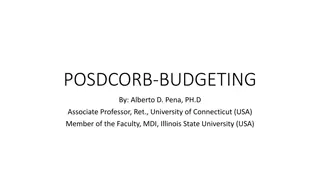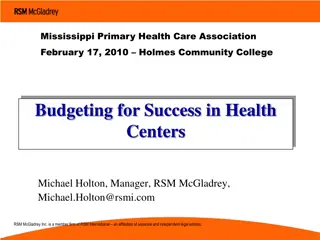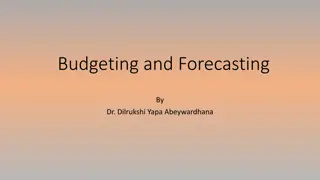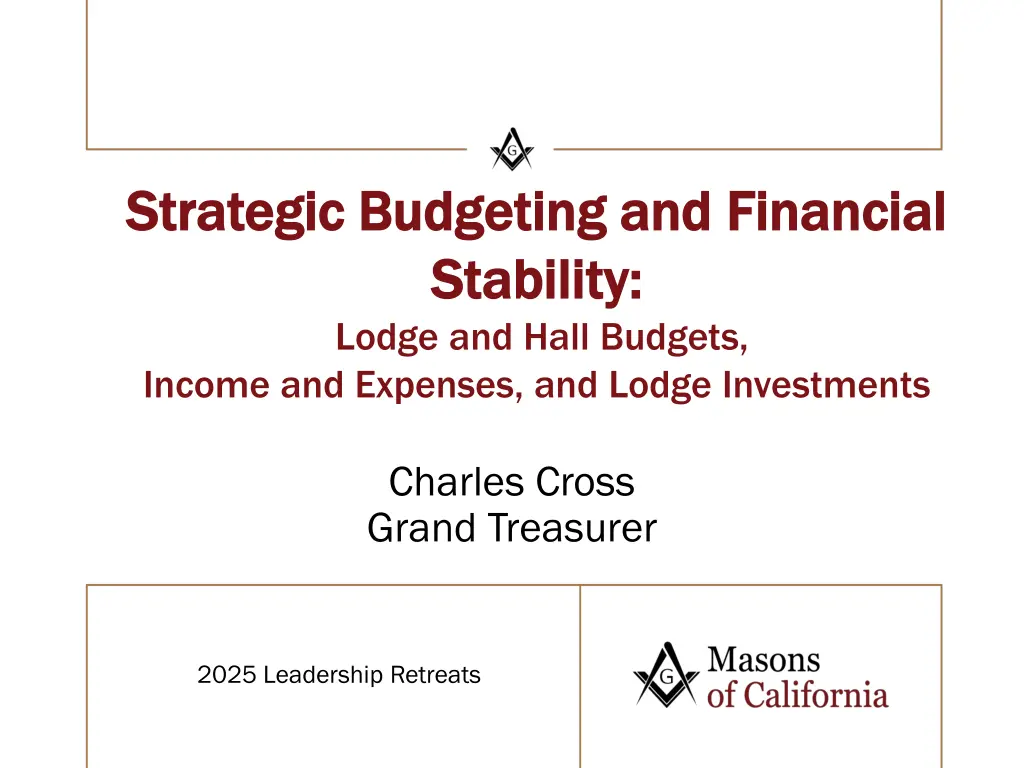
Lodge Financial Management Strategies
Explore essential strategies for managing lodge and hall budgets, including income sources, expenses, and investments. Learn effective budgeting processes, timeline, and key responsibilities for financial stability. Gain insights into income sources such as dues, fees, donations, and other revenue streams to enhance financial planning and decision-making.
Download Presentation

Please find below an Image/Link to download the presentation.
The content on the website is provided AS IS for your information and personal use only. It may not be sold, licensed, or shared on other websites without obtaining consent from the author. If you encounter any issues during the download, it is possible that the publisher has removed the file from their server.
You are allowed to download the files provided on this website for personal or commercial use, subject to the condition that they are used lawfully. All files are the property of their respective owners.
The content on the website is provided AS IS for your information and personal use only. It may not be sold, licensed, or shared on other websites without obtaining consent from the author.
E N D
Presentation Transcript
Strategic Budgeting and Financial Strategic Budgeting and Financial Stability: Stability: Lodge and Hall Budgets, Income and Expenses, and Lodge Investments Charles Cross Grand Treasurer 2025 Leadership Retreats
Agenda & Take Aways Lodge/Hall Budget Lodge/Hall Budget Understand the lodge/hall budget timeline Understand the lodge/hall sources of income and expenses Understand how your lodge/hall prepare its budget Understand customs/needs of the lodge/hall
Budget Agenda Lodge/Hall Fiscal Year begins on January 1st& ends on December 31st For financial reporting and budgeting purposes Timeline: Preparation, Review & Approval High Level Revenue & Expenses
Budget Timeline Ideally, the 2026 operating budget process begins Q1 2025 Lodge Budget responsibility lies with the Senior Warden (Master) Hall Operating and Capital Budget responsibility lies with the President of the Hall Typically, the Senior Warden (Master) solicits budget input from the Master, Secretary, and Treasurer (Q1 - Q3) Draft Budget and Assumptions are provided in October/November for the ensuing masonic year (Q4)
Budget Timeline - continued Lodge s 2026 Operating Budget presented to members at the January 2026 stated meeting for approval and adoption (Required per CMC) Hall s 2026 Operating and Capital Budgets presented to board for approval during the January 2026 board mtng Hall s Capital Budget is a multi-year capital plan, so it should be refreshed annually
Lodge Income Sources Income sources (2 categories): 1. Primary Sources Dues (Annual Membership) Fees (Degree, Out of State Affiliation, etc ) Life Membership Distributions Investment Distributions
Lodge Income Sources 2. Other Sources Gifts & Bequests Income from donor restricted gifts and trusts Transfer from Hall Association Contributions Other Revenue (Events, etc )
Lodge Income Sources Annual Membership Dues Annual dues paid by the member to the lodge unless he is a life member or by action of the lodge, his dues are remitted. October/November dues notice is distributed to the members Lodges who opted into the Grand Lodge Dues invoicing program Grand Lodge sends notice electronically and in paper to the member. Dues paid online through iMember are processed and settled every 10th of the month e.g. Dues payment received by Grand Lodge in December will be settled and paid to the lodge on January 10th Details of payment is on iMember
Lodge Income Sources Life Membership A member can purchase life membership. The purchase price for such life membership shall be paid in full at the time of purchase and calculated in accordance with Section 809.320 of the CMC and the current life membership plan of the lodge. A lodge purchasing a life membership for retiring Master as provided in Section 809.550.D of the CMC, must transfer the total purchase price of the life membership from its general funds to its Life Membership Fund. It should be booked as a life membership income and Other discretionary expenses.
Lodge Income Sources Investment Distribution From General investment to support operating expenses of the lodge From scholarship fund to support lodge scholarship From building fund to support hall association operating and capital expenditures From life membership maximum allowable withdrawal during the calendar year is 4% of the average value of investment except If the fund exists for less than three complete calendar years, but for at least one complete calendar year 4% of the averaged together If the fund was created in the prior calendar year 4% of the value on December 31 prior year calendar If the fund was created during the current calendar year no withdrawal is allowed
Lodge Income Sources Other Sources Gifts/Contributions and Bequests - A Lodge may accept contributions, gifts, bequests and other financial assistance from its own Masons at any time and from other persons and entities. Contributions to the lodge, a 501c 10 organization, is not tax deductible unless such contributions are to be used exclusively for religious, charitable, scientific, literary, or educational purposes, or for the prevention of cruelty to children or animals
Lodge Income Sources Other Sources Continuation Transfer from the Hall Association This is the income distribution from the Hall Association. The Hall is a 501c 2 organization organizes exclusively for holding title to property, collecting income and turning over the entire amount of income, less expenses to the lodge. Distribution to the lodge should be no less than annually Hall can establish reasonable reserves for operation, future repairs and improvements provided the amount is determined and approved by the Lodge. If plans change or the funds are no longer needed for the planned purposes, the excess funds should be remitted promptly to the Lodge.
Lodge Income Sources Other Sources Continuation Other Revenue Fundraising crab feed, golf tournament, pancake breakfast, sweetheart brunch, etc
Lodge Expenditures Lodge funds shall not be used/expended without the express consent of the Lodge, even though included in a Lodge budget, except for the following Dispensed by the Charity Committee Due/payable to Grand Lodge e.g. per capita To pay the taxes or other charges of local, State or Federal governmental agencies, or Return of dues under section 809.350 of the CMC
Lodge Expenditures PROHIBITED EXPENDITURES (CMC 809.530) A lodge may not: Use/expend lodge funds for alcoholic beverages; Divide its monies, property or other assets with its members, even those withdrawing to form a new lodge or with the new lodge thus formed; Divide its funds with an existing lodge by way of a contribution; Invest lodge funds in its life membership fund, other than to purchase a life membership for its retiring master; or Use any of its funds to subsidize, directly or indirectly, any organizations except Masonic Youth Orders or as otherwise provided in the CMC.
Lodge Expenses Four Expense Categories: 1. Required and necessary expenditures (CMC 809.540) 2. Discretionary expenditures (CMC 809.550) 3. Social and fraternal expenditures (CMC 809.560) 4. Budget reserve for contingency
Lodge Required & Necessary Expenditures 2026 Per Capita Fees/Degree Fees/Out of State Affiliations 2026 Per Capita $68.50 (Billed in August 2025 For Grand Lodge 2026 Per Capita $68.50 (Billed in August 2025 For Grand Lodge 2026 Fiscal Year) 2026 Fiscal Year) Includes $1 Per Capita Assessment to George Washington Masonic National Memorial Out of State (Only) Affiliation Application Fees Out of State (Only) Affiliation Application Fees $30 Application Fee due to Grand Lodge $45 background check (Effective July 2025) $25 Fee to Masonic Homes Degree (Application) Fees Degree (Application) Fees $30 Application Fee due to Grand Lodge $45 background check (Effective July 2025) $25 Fee to Masonic Homes $15 Fee to George Washington Masonic National Memorial $9 Fee to CA Masonic Memorial Temple Relief to Master Masons, widows or orphans (estimate) Assistance with Funeral and Burial Expenses of a member
Lodge Expenses Required and Necessary Expenditures (Continued) Relief to master masons, widows or orphans CMC 812.010 - It is the duty of every Lodge to aid and assist every needy Master Mason of that Lodge, wherever he may reside, and every needy Master Mason of another Lodge in this or any other Jurisdiction who resides within the vicinity of that Lodge. This duty extends to the needy widow and dependent orphans of a Master Mason of that Lodge and the needy widow and dependent orphans of a Master Mason of another Lodge in this or any other Jurisdiction who reside within the vicinity of that Lodge. A Lodge s duty of relief is limited only by its own circumstances and ability Taxes and Other Government Charges e.g. tax filing fee, application fee among others Assistance with funeral and burial expenses of a member
Lodge Expenses Discretionary Expenses (Continued) Employment Lodge Employees Secretary Assistant Secretary Treasurer Tiler Organist Employment Taxes - Mandatory FICA 7.65% (Medicare 1.45% & Soc. Sec. 6.2%) Lodge Programs Communication and Operations
Lodge Expenses Discretionary Expenses (Continued) Employment The following officers are considered Lodge employees, subject to withholding taxes, if compensated Secretary Assistant secretary Treasurer Tiler Organist
Lodge Expenses Discretionary Expenses (Continued) Employment continuation Corporate officers are statutory employees for unemployment insurance, employment training tax and state disability insurance purposes according to California Unemployment Insurance Code 621(c)(1 Per California Labor Code AB 5 - Individual paid for services is classified as employee unless the following conditions are met: A. The person is free from the control and direction of the hiring entity in connection with the performance of the work, B. The person performs work that is outside the usual course of the hiring entity s business. C. The person is customarily engaged in an independently established trade, occupation, or business of the same nature as that involved in the work performed.
Lodge Expenses Employment continuation - Employee vs Independent contractor California ABC Test Is the worker free from the control and direction of the entity in connection with the performance of the work? EMPLOYEE NO Yes Does the worker perform work outside the entity s usual course of business NO Yes Does the worker perform work outside the entity s usual course of business NO Independent Contractor Yes
Lodge Expenses Discretionary Expenses Employment continuation Employment taxes - mandatory FICA 7.65% (Medicare 1.45% and Soc. Sec. 6.2%) Unemployment insurance Federal - 6% to the first 7,000 you paid to each employee State 1.5% to 6.2% to the first 7,000 you paid to each employee
Lodge Expenses Discretionary Expenses (Continued) Lodge program expenses Annual Communication, District Officer Meeting, Secretary s meeting Public School Observance, Constitution observance Scholarship among others Education and Training candidate education, Masonic publication, Master and Warden retreats, Secretary and Treasurer retreats, officer s management workshops
Lodge Expenses Discretionary Expenses (Continued) Honors and awards Relief Contributions to Masonic Homes, California Masonic Foundation, Masonic Homes residents and other Masonic relief Transfer to the Hall Association for operation Other Discretionary expenses
Lodge Social & Fraternal Expenses Community Improvement Charitable Activities Refreshment Fund Officers Installation Expenses Other Social and Fraternal Expenditures Social & Fraternal Expenses Cannot Exceed 30% of income from dues, fees and investments Offsetting Event Expenses with Event Revenue is allowed. Social expenses incurred from hosting a charitable event do not count against the 30% rule.
Tips for Any Budget Creation Start with a set of assumptions Identify all potential expenses Identify all revenue sources Put it in writing (narrative) Use a standard budget template (Excel) For both Lodge and Hall
Tips for Any Budget Creation Track budget progress in different versions (e.g. draft 1, 2, final) Always present a balanced budget Worst case scenario: A break-even budget Best Case Scenario: Budgeted surplus Not Recommended: A budget with a deficit
Hall Operating and Capital Budget Operating Budget 1 year Capital Budget Multi-Year Capital plan
Hall Types and Revenue Sources Hall Type Hall Type Revenue Source Revenue Source Financial Impact on Financial Impact on Halls During Halls During economic downturn economic downturn and recovery period and recovery period Small 1 or 2 story building with lodge room & small dining room only Lodge revenue only No to Minimal revenue loss Small 1 or 2 story building with lodge room & small dining room only Fraternal (lodge and masonic affiliates) Minimal revenue loss Medium size building Fraternal and single use events revenue Minimal to Moderate revenue loss Mid to Large size building with lodge room (2nd floor) and commercial space (ground level) Fraternal and commercial leases revenue Minimal to Significant revenue loss Large size building with lodge room (2nd floor) and commercial space (ground level) Fraternal revenue, commercial leases, and single use events revenue Minimal to Significant revenue loss
Hall Income Sources Income sources: 1. Primary Sources Rent from Lodge(s) Rent from other masonic orgs (Concordant Bodies) Rent from Non-Masonic Orgs/Commercial Tenants Rent from One-Time (Single Use) Events 2. Other Sources Rent from Parking Lot Transfer from Owner Lodge Other Miscellaneous Revenue
Hall Expenses Payrolls (Hall employees) Admin Expenses Property Management Fees Tax filing fees Payroll processing fees Property Tax Property & Liability Insurance Premiums Utilities (Gas, Electric, Water, Trash) Outsourced Services Janitorial/Cleaning Services Guard/Security Services Landscaping/Groundskeeping Services Pest Control
Hall Expenses (Continued) Other Building Expenses Fire Extinguisher inspections Burglar alarm monitoring service Telephone Service Internet Service Elevator Services contract Budget Reserve for Contingency Revenue net Expense = Operating Surplus/Deficit If Hall has a year end operating surplus, Transfer Fund to Lodge (dividend from Operations)
Maintenance and Capital Plans The hall association s primary responsibility is to protect the assets of the lodge and ensure the building is kept in good/operable condition Safety/Security Public image & improved membership experience Attract more rentals = revenue Develop annual maintenance plan Develop multi-year capital plan * maintain federal and state tax exemption w/ the IRS & FTB in good standing
Building Maintenance Plan Create an annual maintenance plan Include maintenance items in Hall s budget Determine frequency of services/inspections Frequently review the plan Include: Landscaping Window cleaning HVAC service Roof repairs Plumbing, etc.) Hall s annual operating - Housekeeping - Painting - Fire extinguishers - Other (Electrical, etc.)
Capital Improvements Planning Process Major improvements expenses should be included in the capital budget, not the operating budget Create a long-term improvements plan Engage professional architects/contractors Develop effective funding sources and strategy
Capital Improvements Planning Process Obtain proper approvals (owner lodge, city/county, & Grand Lodge Committees* *) Conduct all business in a prudent and transparent manner Report regularly to and solicit input from hall association board and owner lodge(s)
Capital Expense Approval Capital Projects < $25,000 Lodge and Hall approval only Capital Projects > $25,000* * + Grand Lodge Masonic Properties Committee Capital Projects > $100,000* * + Grand Lodge Executive Committee City/County approval, where applicable
Multi-Year Capital Plan Assess the building needs for the next 3, 5, or 10 years: Interior & Exterior Structural Plumbing Electrical Mechanical HVAC ADA/Code Compliance
Five Year Capital Improvements Plan Task/Year Task/Year Priority Priority Level Level 2025 2025 2026 2026 2027 2027 2028 2028 2029 2029 Total Total 5 5- -year year spending spending Roof HVAC System Furniture & Fixtures Lighting Flooring Kitchen &/or Restroom Renovations Interior &/or exterior Paint Plumbing &/or electrical Parking lot repaving Solar Panel Installation Total capital expense by year Total capital expense by year
Three-Year Capital Plan - Example Task/Year Task/Year Priority Priority Level Level 2025 2025 2026 2026 2027 2027 Total Total 3 3- -year spending year spending Replace Roof with 20-yr warranty 1 $50,000* $50,000 LED Lighting fixtures (interior & exterior) 1 $10,000 $10,000 Replace kitchen appliances 2 $15,000 $15,000 Bathroom remodel (upgrade fixtures, toilets, faucets, etc.) 2 $25,000* $25,000 Replace A/C units 1 $25,000 $25,000 Solar Panel Installation with 20- year warranty 3 $40,000* $40,000 Replace carpet in lodge room and common areas 2 $25,000* $25,000 Re-surface/re-stripe parking lot 3 $35,000* $35,000 Total capital expense by year Total capital expense by year $85,000 $85,000 $65,000 $65,000 $75,000 $75,000 $225,000 $225,000 * Requires MPC approval * Requires MPC approval
Summary Plan ahead Failure to Plan is Planning to FAIL Keep the two (lodge/Hall) Budgets separate If using Grand View for Accounting, enter your approved annual budget in the system (financial services can provide support); spread budget by month (if possible); this is relevant when generating actual to budget variance reports Treasurer should not be passive in the business operation of a lodge/hall
Summary Appropriate internal/external reporting is critical Coordinate/Fully Cooperate with the Audit Committee If you need assistance: a. Refer to the CMC b. Solicit input from Other Officers (Past and Present) c. Contact the Grand Treasurer or the CFO
Lodge investment programs Lodge investment programs Charles Cross Grand Treasurer 2025 Lodge Leadership Summits
Lodge Investments Overview Lodge Investments Overview Options available to lodges for the investment of assets How to take advantage of these programs Asset performance How to access your funds
Options for Lodge Investments Options for Lodge Investments Grand Lodge Life Investment Program Grand Lodge Life Investment Program Grand Lodge General Investment Program Grand Lodge General Investment Program Investment Committee or Board of Trustees Investment Committee or Board of Trustees Direct Investment Management Direct Investment Management
GL Life Membership Investment GL Life Membership Investment Program Program Available to all lodges regardless of fund size. Grand Treasurer, with the assistance of the GL Investment committee is responsible for investment decisions. Minimum long-term investment objective is to cover the distribution program (4%) + Inflation (CPI). Currently the Life Membership Program is Invested in the TIAA Kaspick Growth/Income Fund. Current balance is $3,421,875 comprised of 66 lodges as of 12/31/2024.
GL Life Membership Investment GL Life Membership Investment Program Program TIAA Kaspick TIAA Kaspick Growth/Income Fund Mix Growth/Income Fund Mix Investment Mix as of 12/31/2024 Equities 56% Fixed Income 43% % Cash 1 1%
GL Life Membership Investment GL Life Membership Investment Program Program TIAA TIAA Kaspick Kaspick Growth/Income Investment Performance Growth/Income Investment Performance as of 12/31/2024 as of 12/31/2024 Growth/Income Fund Growth/Income Fund 7.3% CPI CPI 2.9% 4% dist. + CPI 4% dist. + CPI 6.9% One Year Three Years 0.4% 4.2% 8.2% Five Years 4.1% 4.2% 8.2% Ten Years n/a 3.0% 7.0%
Grand Lodge General Investment Grand Lodge General Investment Program Program Available to all lodges. Grand Treasurer, under the advice of the GL investment committee responsible for all investment decisions. Minimum long-term investment objective is to cover the distribution percent (4.00%) + CPI The Lodge General Investment Program is invested in the Grand Lodge ETF Investment Mix. Current balance is $30,132,523 comprised of 40 as of 12/31/2024 lodges compared to $23,430,120 comprised of 36 lodges as of 12/31/2023.

